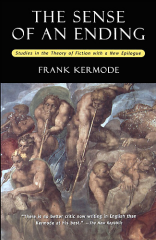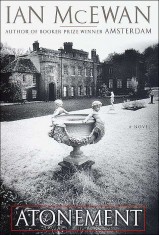The Sense of an Ending by Julian Barnes, Jonathan Cape 2011.

“I remember.” These are the opening words in Julian Barnes’s eminently readable Man Booker prizewinner, The Sense of an Ending. “I remember” is a seductive phrase, luring the reader into a character’s life, setting up expectations of intimate revelations as the reader settles into the confessional. But of course, the title itself is a warning, invoking as it does Frank Kermode’s 1967 seminal study, The Sense of an Ending.
Kermode explored the relationship between storytelling, time and total devastation. Fiction-writing is an attempt to order the chaos of human experience, imposing on it a beginning – as Barnes does, in the words, “I remember” – and also an ending. But Barnes’s final phrase suggests that in each ending there is a beginning, as the disturbance caused by human action is never in fact apocalyptic, rippling and surging, instead, in an eternal “unrest”; so, while fiction may give us the sense of an ending, Barnes reminds us that there can never be neat closure or resolution. And more than mere open-endedness, the word “unrest” suggests ongoing disturbance and turbulence. In that sense, Barnes’s novel perfectly captures the zeitgeist.
So, clearly, for all its “readability” – the controversial criterion for 2011's Booker award – Barnes’s novel is deceptive in its supposed simplicity. Following on from Hilary Mantel’s historical tome, Wolf Hall, and hot on the heels of Howard Jacobson’s demanding The Finkler Question, Barnes’s novel is the second-shortest in the Booker’s history. At a neat 150 pages, The Sense of an Ending is a complex meditation on memory, the passage of time, and the meaning of friendship. It is also an exploration of the peculiarities of Englishness and the persistence of class prejudices. In addition to all this, it is a slow, relentless unveiling of ordinariness, of the darkness that lurks below the surface of its “peaceable” protagonist, Tony Webster, who describes himself thus: “Average, that’s what I’d been ever since I left school.”
That word “average” is a red flag to the alert reader. There really is no such thing as an average person or an average life, as the smallest ripples caused by human intervention can become tsunamis. So, to get back to Kermode: fiction employs peripeteia, which is a sudden change in the plot, subverting the reader’s

expectations. After Tony’s opening words, “I remember”, he lists an apparently random set of images, familiar, banal, even – a wrist, a frying pan, sperm, a river. The elements of human tragedy, suggesting the tick-tock of time, sexual encounter – and the workings of the unconscious in various images of water.
While familiar, however, the banal objects seem surreal. First, the “shiny inner wrist“ is a reference to the way Tony and his friends wore their watches – a sixties fashion among youth. But the wrist is also where an artery lies close to the surface of the skin. Then the frying pan being tossed into the sink, causing steam to rise – an apparently innocent action demonstrating a woman’s enjoyment of the “small havoc” she has caused, which powerfully prefigures the “havoc” caused by her later action. The image of the “gout of sperm” conjures up sex – and as it drains away into a plughole, the sperm also conjures up death.
Tony’s friend, the “serious” schoolboy, Adrian, identifies the nexus between Eros and Thanatos, which later plays out in his own life and that of his friend. Tony’s strange list includes various images of water – steam, rivers, bathwater – all artfully spun into a subtle plot. But it is the last image on the list that is especially enigmatic – a memory of something not seen, but imagined, containing elements of menace and secrecy, relating to a suicide.
Indeed, suicide runs like a dark thread through the novel, starting with the suicide of one of Tony and Adrian’s schoolmates. But in that callow manner that is typical of youth, the boy’s suicide is glossed over, without any understanding of its causes or consequences. And that remains the problem: Barnes tackles the failure of us all to see and comprehend what is going on around us – until it is far too late.
The story traces the lives and loves of four schoolboys, gradually narrowing its focus to the friendship between Tony and Adrian – a character whose probing mind, whose quest for the meaning of life, is counterbalanced by the complacency of the more superficial and bland Tony, the narrator of the story. The slow introduction to the action takes place in Bristol, in the 1950s and 1960s, decades that overlap and intersect, refusing the neat categorisations usually imposed on the baby boomer generation. There’s lots of talking about sex, no drugs to speak of, and some significant rock and roll. Barnes is very careful to situate the novel in the period, mentioning for example a film such as Spartacus – slyly winking at Kermode’s New Critical anti-historicism, which pays no attention to the social context of a work.
The catalyst in the story is Veronica, an interesting, problematic character. Boy meets girl, and so far, perhaps, so good. But after breaking up with Veronica, Tony has sex with her, abandons her, and she takes up with his best friend, Adrian. Then, crucially, Tony writes two letters to Adrian, conveniently forgetting that he’d ever written the second one. As inevitably as a hot frying pan will cause steam to rise in a sink, this letter has repercussions. Its effect is to cause the smooth flow of the river of people’s lives to be excited, the past “rushing nonsensically upstream”.
The past is never past, Tony realises, as the letter’s contents are revealed to have had a devastating impact on the lives of his two erstwhile friends. Barnes asks many questions about repression and denial, and facing up to the things we do to others, and the remorse that results from the hurt and damage caused by careless words and actions.
In dealing with such questions, Barnes situates the novel in the great tradition of the English novel, where characters such as Henry James’s Isabel Archer in The Portrait of a Lady, or more recently Ian McEwan’s Briony in Atonement, must face the devastation they have caused to their own lives and the lives of those they love. In

a 21st century novel such as The Sense of an Ending, the very act of storytelling is seen to be suspect and behaviour is seen to be shaped by contemporary values and attitudes. Running like a refrain through Tony’s story is the Rolling Stones song, “Time is on My Side” – an ironic reminder that Time is not, in fact, an ally at all; instead, it is the continuum in which the consequences of our deeds unfold. Tony comes to realise, to his chagrin and shame, “how time first grounds us and then confounds us.”
As a schoolboy, Tony fears that “[l]ife wouldn’t turn out to be Literature” – with its grand themes of love, sex, suffering, betrayal and suicide. But he eventually comes to realise that the greatest tragedies happen on an individual level, to the most ordinary and apparently “peaceable” among us, in our fallibility and incapacity to comprehend our own motives or those of others. In the words of Veronica, we simply “don’t get it” – and see life through a glass, darkly.
Barnes’s narrative style is ironic, sardonic at times, deceptively downplaying the high seriousness of human life. Early on in the novel, Tony realises the difference between himself and his two schoolmates, and Adrian: “We were essentially taking the piss, except when we were serious. He was essentially serious, except when he was taking the piss.” And so, in a novel where taking the piss is playfully spliced with seriousness, the last word should perhaps be Adrian’s emphatic: “I hate the way the English have of not being serious about being serious. I really hate it.”
*This is an expanded version of a review broadcast on Fine Music Radio.
 SLiPStellenbosch Literary Project
SLiPStellenbosch Literary Project